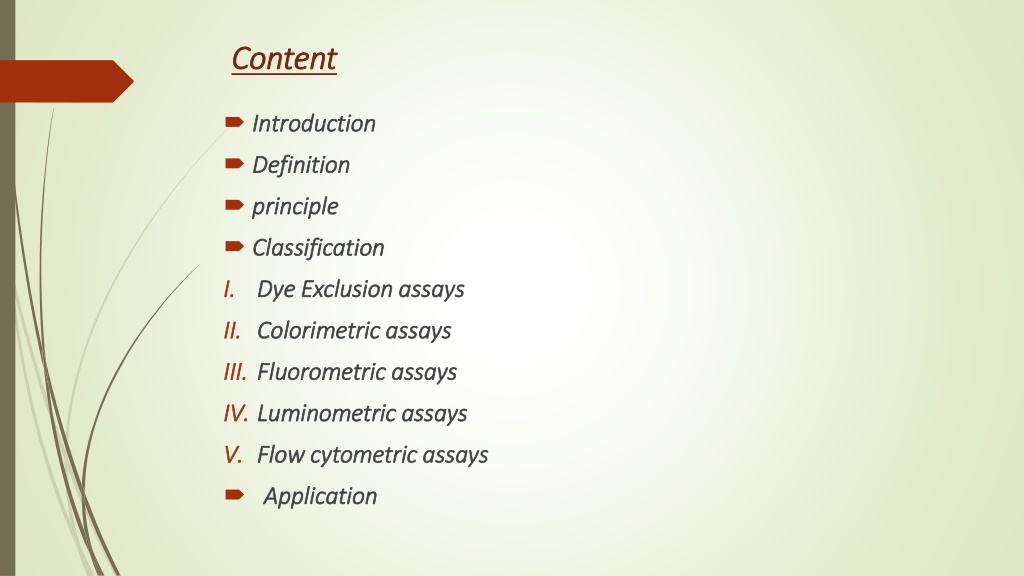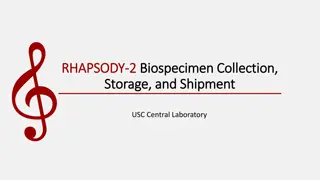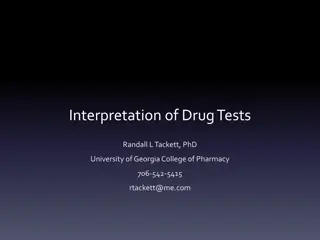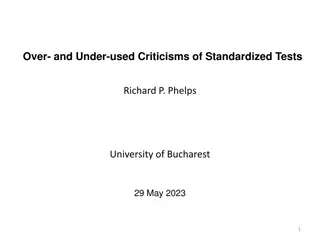Understanding Cell Viability Assays in Laboratory Testing
Cell viability assays play a crucial role in determining the health and status of cells, measuring their ability to survive and proliferate. These assays involve various techniques such as dye exclusion, colorimetric, fluorometric, luminometric, and flow cytometric assays. By assessing factors like cell membrane permeability, enzyme activity, ATP production, and cell adherence, researchers can evaluate cytotoxicity and cell toxicity effectively. The applications of cell viability assays range from detecting diseases to screening drugs, making them indispensable in laboratory settings.
Download Presentation
Please find below an Image/Link to download the presentation.
The content on the website is provided AS IS for your information and personal use only. It may not be sold, licensed, or shared on other websites without obtaining consent from the author. Download presentation by click this link. If you encounter any issues during the download, it is possible that the publisher has removed the file from their server.
Presentation Transcript
Content Content Introduction Introduction Definition Definition principle principle Classification Classification I. I. Dye Exclusion assays Dye Exclusion assays II. II. Colorimetric assays Colorimetric assays III. III. Fluorometric assays Fluorometric assays IV. IV. Luminometric assays Luminometric assays V. V. Flow cytometric assays Flow cytometric assays Application Application
Cell viability Cell viability Cell viability defined as the no. of healthy cell in a sample, determines Cell viability defined as the no. of healthy cell in a sample, determines the amount of cells that are living or dead, based on a total cell the amount of cells that are living or dead, based on a total cell sample. sample. There are several assay developed in the laboratory for measuring the There are several assay developed in the laboratory for measuring the cell viability and cell toxicity. cell viability and cell toxicity.
A majority of the cytotoxicity and cell viability assays are A majority of the cytotoxicity and cell viability assays are based on the various cell functions such as based on the various cell functions such as- - Cell membrane permeability Cell membrane permeability Enzyme activity Enzyme activity ATP Production ATP Production Co Co- -enzyme production enzyme production Cell adherence Cell adherence
Application of cell viability assay Application of cell viability assay TO detect cytotoxic or inhibitory lymphokines TO detect cytotoxic or inhibitory lymphokines To detect mammalian cell survival and proliferation To detect mammalian cell survival and proliferation To diagnose disease To diagnose disease To screen drug To screen drug
Classification of cell viability assay: Classification of cell viability assay:- - Luminometric assays Dye exclusion assays Colorimetric assays Fluorometric assays Radioisotopes incorporation assay
1. 1. Dye exclusion assay: Dye exclusion assay:- - Example Example Trypan blue, eosin, congo red, erythromycin Trypan blue, eosin, congo red, erythromycin Principles Principles- - In dye exclusion method , viable cells exclude dye, but In dye exclusion method , viable cells exclude dye, but dead cells not exclude them. dead cells not exclude them. The viable cells are impermeable to several dyes such as The viable cells are impermeable to several dyes such as naphthalene black, trypan blue, eosin Y, nigrosine green and naphthalene black, trypan blue, eosin Y, nigrosine green and erythrosine B. erythrosine B. Useful for determination of membrane integrity. Useful for determination of membrane integrity. The technique basically consists of mixing the cells in suspension The technique basically consists of mixing the cells in suspension with the dye and examining them under the microscopy. with the dye and examining them under the microscopy.
The stained cells and the total number of cells are counted. The stained cells and the total number of cells are counted. The % of unstained cells represent the viable cell. The % of unstained cells represent the viable cell.
Colorimetric Colorimetric MTT ASSAYS MTT ASSAYS SRB ASSAYS SRB ASSAYS
Colorimetric assays Colorimetric assays Based on measurements of biochemical marker 1 to evaluate Based on measurements of biochemical marker 1 to evaluate metabolic activity of the cells. metabolic activity of the cells. MTT assay is one of the most commonly used clorimetric MTT assay is one of the most commonly used clorimetric assay. assay. Determination of mitochondrial function of cell by measuring Determination of mitochondrial function of cell by measuring activity of mitochondrial enzyme such as succinate activity of mitochondrial enzyme such as succinate dehydrogenase. dehydrogenase. MTT is reduced to a purple formazon by NADH. MTT is reduced to a purple formazon by NADH.
MTT ASSAY MTT ASSAY Seed cells in 96 well Seed cells in 96 well MTT ASSAY PROCEDURE MTT ASSAY PROCEDURE Incubate at 3c for 24 hour Incubate at 3c for 24 hour Add 20 or 5ml. MTT to each cell Add 20 or 5ml. MTT to each cell Incubate at for 4 hours Incubate at for 4 hours c Carefully remove medium and add Carefully remove medium and add 200ul DMSO to each well. 200ul DMSO to each well.
Fluorometric assay Fluorometric assay Alomar blue assay Alomar blue assay CFDA assay CFDA assay Easy to perform with the use of a fluorescence microscope , Easy to perform with the use of a fluorescence microscope , fluorometer, fluorescence microplate reader or floe fluorometer, fluorescence microplate reader or floe cytometer. cytometer. Fluorometer assays are also applicable for adherent or Fluorometer assays are also applicable for adherent or suspended cell lines and easy to use. suspended cell lines and easy to use. These assay are more sensitive than colorimetric assay. These assay are more sensitive than colorimetric assay.
Luminometric assay Luminometric assay
IN ATP ASSAY cellular ATP is one of the most sensitive end in measuring IN ATP ASSAY cellular ATP is one of the most sensitive end in measuring cell viability. cell viability. Damaged cells loss membrane integrity to ability to synthesis the ATP Damaged cells loss membrane integrity to ability to synthesis the ATP AND ATP level of cells decrease dramatically. AND ATP level of cells decrease dramatically. The ATP based assay is based on the reaction of luciferin to oxyluciferin. The ATP based assay is based on the reaction of luciferin to oxyluciferin. Enzyme luciferase catalyzes this reaction in the presence of the mg. ion Enzyme luciferase catalyzes this reaction in the presence of the mg. ion And ATP , yielding a luminescent signal. And ATP , yielding a luminescent signal.

















































